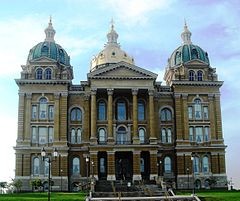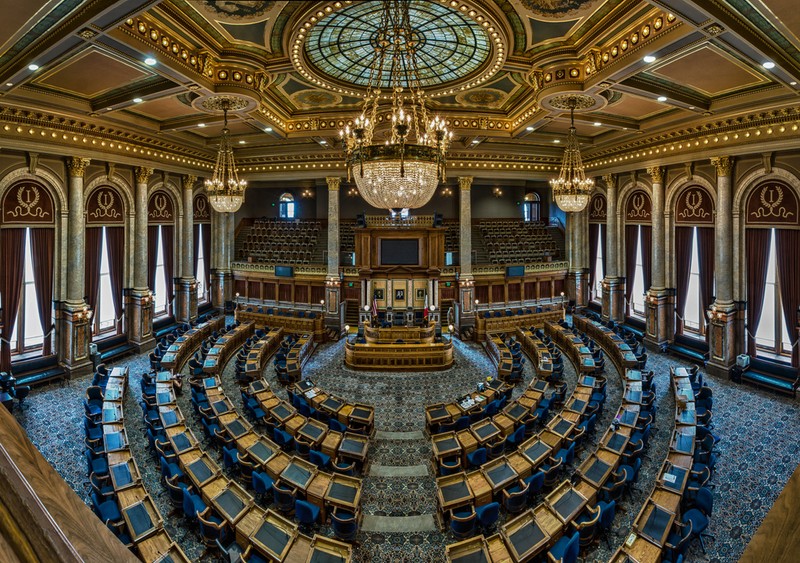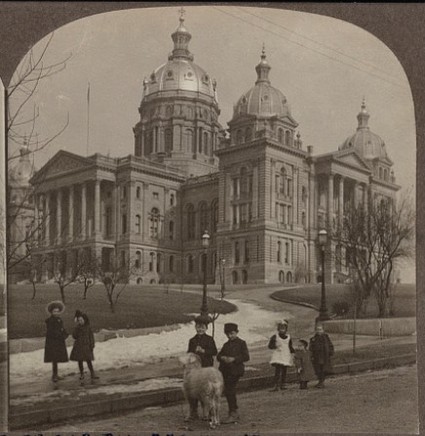Iowa State Capitol
Introduction
Text-to-speech Audio
The State Capitol building which is the heart of the Iowa government was constructed between 1871 and 1886, and features a commanding central dome made of iron and brick and covered with 23-carat gold. Other impressive aspects are four smaller domes on each corner and panoramic views of the city from its position atop a large hill. Highlights in the interior include a marble grand staircase, a frieze around the columnns bearing a quote from the Lincoln's Gettysburg address, a magnificent historic mural, the battle flags of Iowa regiments, and a scale model of the battleship USS Iowa. There is a cafeteria on the ground floor. The capitol was named to the National Register of Historic Places in October 1926.
Images
The Iowa State Capitol was built in 1886 and is listed on the National Register of Historic Places.


The Senate Chambers

The House of Representatives


Photo of children & a goat in front of Capitol Building around 1906 (C.L. Watson)

Backstory and Context
Text-to-speech Audio
The capitol was finally finished in 1886, but the process finding a location for it began in 1846, the same year Iowa was granted statehood. The first General Assembly formed a commission to find a suitable location; it determined that the site should be west of Iowa City. Jasper County petitioned that the capitol be built there and the Assembly first accepted that but later rejected the location. Finally, in 1854 the Assembly decreed that the Capitol would be located near the Des Moines River on nine acres of land donated by Wilson Alexander. The Assembly decreed in 1857 that Des Moines would the Iowa's capital city. Des Moines citizens actually built a temporary capitol that stood for thirty years until it burned down.
In 1870, architects J. Cochrane and A. Piquenard were hired to design a new capitol building. Cochrane resigned two years later and Piquenard died in 1876. Two of their assistants continued to work on the project, one of whom remained until the building was completed in 1886. The building was dedicated in 1884, as the General Assembly hall was finished and in session for the first time. The Governor's office and other offices were completed a year later and the Supreme Court room was completed in 1886. The cost of constructing the Capitol exceeded $2.8 million dollars.
The building has required restoration several times since 1886. Modernization efforts began in 1902. Unfortunately, as these were underway, a 1904 fire severely damaged the House of Representatives and the Supreme Court. The fire resulted in over $3 million dollars in repairs. In the 1970s and 1980s, the interior and exterior of the building underwent restoration. The Victorian interior was considered out of date by the 1950s so as a result much of the interior was altered to match the tastes of the time. However, the country's 200th birthday prompted efforts to restore the interior to the original Victorian Style. On the exterior, by 1980 much of the sandstone cladding was badly eroded. Exterior restoration commenced in 1998 and completed in 2001. Hence significant parts of what you see are unoriginal.
Sources
Brockett, Glenn F. "Iowa State Capitol Building," National Register of Historic Places - Nomination Form. 10-21-76. http://pdfhost.focus.nps.gov/docs/nrhp/text/76000799.PDF.
"Capitol Facts." https://www.legis.iowa.gov/resources/capitolFacts.
"State Capitol." Iowa Official Register, 2007-2008, vol. 72, pp: 383-393. http://publications.iowa.gov/6421/9/Chapter_8_Iowa_Profile.pdf.
https://www.loc.gov/item/2003675050/
